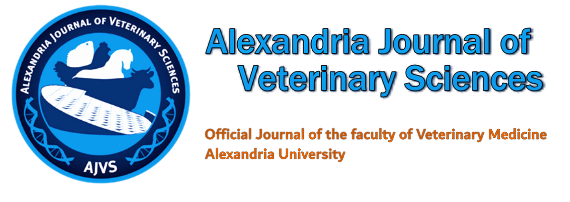
| Original Article | ||||||||||||
AJVS. 2022; 72(2): 46-54 doi: 10.5455/ajvs.66482 Occurrence and Antibiotic Susceptibility of Methicillin-Resistant Staphylococcus aureus Isolated from Dogs and Their Contacts Merhan T. Abdallah, Samy A. Khalil, Mohamed A. Nossair, Alaa M. Mansour.
| ||||||||||||
| How to Cite this Article |
| Pubmed Style Abdallah MT, Khalil SA, Nossair MA, Mansour AM. Occurrence and Antibiotic Susceptibility of Methicillin-Resistant Staphylococcus aureus Isolated from Dogs and Their Contacts. AJVS. 2022; 72(2): 46-54. doi:10.5455/ajvs.66482 Web Style Abdallah MT, Khalil SA, Nossair MA, Mansour AM. Occurrence and Antibiotic Susceptibility of Methicillin-Resistant Staphylococcus aureus Isolated from Dogs and Their Contacts. https://www.alexjvs.com/?mno=66482 [Access: May 04, 2025]. doi:10.5455/ajvs.66482 AMA (American Medical Association) Style Abdallah MT, Khalil SA, Nossair MA, Mansour AM. Occurrence and Antibiotic Susceptibility of Methicillin-Resistant Staphylococcus aureus Isolated from Dogs and Their Contacts. AJVS. 2022; 72(2): 46-54. doi:10.5455/ajvs.66482 Vancouver/ICMJE Style Abdallah MT, Khalil SA, Nossair MA, Mansour AM. Occurrence and Antibiotic Susceptibility of Methicillin-Resistant Staphylococcus aureus Isolated from Dogs and Their Contacts. AJVS. (2022), [cited May 04, 2025]; 72(2): 46-54. doi:10.5455/ajvs.66482 Harvard Style Abdallah, M. T., Khalil, . S. A., Nossair, . M. A. & Mansour, . A. M. (2022) Occurrence and Antibiotic Susceptibility of Methicillin-Resistant Staphylococcus aureus Isolated from Dogs and Their Contacts. AJVS, 72 (2), 46-54. doi:10.5455/ajvs.66482 Turabian Style Abdallah, Merhan T., Samy A. Khalil, Mohamed A. Nossair, and Alaa M. Mansour. 2022. Occurrence and Antibiotic Susceptibility of Methicillin-Resistant Staphylococcus aureus Isolated from Dogs and Their Contacts. Alexandria Journal of Veterinary Sciences, 72 (2), 46-54. doi:10.5455/ajvs.66482 Chicago Style Abdallah, Merhan T., Samy A. Khalil, Mohamed A. Nossair, and Alaa M. Mansour. "Occurrence and Antibiotic Susceptibility of Methicillin-Resistant Staphylococcus aureus Isolated from Dogs and Their Contacts." Alexandria Journal of Veterinary Sciences 72 (2022), 46-54. doi:10.5455/ajvs.66482 MLA (The Modern Language Association) Style Abdallah, Merhan T., Samy A. Khalil, Mohamed A. Nossair, and Alaa M. Mansour. "Occurrence and Antibiotic Susceptibility of Methicillin-Resistant Staphylococcus aureus Isolated from Dogs and Their Contacts." Alexandria Journal of Veterinary Sciences 72.2 (2022), 46-54. Print. doi:10.5455/ajvs.66482 APA (American Psychological Association) Style Abdallah, M. T., Khalil, . S. A., Nossair, . M. A. & Mansour, . A. M. (2022) Occurrence and Antibiotic Susceptibility of Methicillin-Resistant Staphylococcus aureus Isolated from Dogs and Their Contacts. Alexandria Journal of Veterinary Sciences, 72 (2), 46-54. doi:10.5455/ajvs.66482 |








